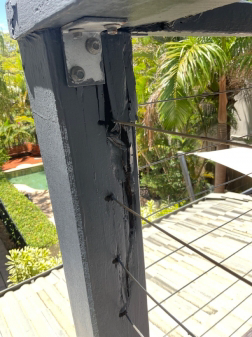Comprehensive Pest Inspections are usually conducted alongside Pre-Purchase or Pre-Sale Building Inspections as a comprehensive Building and Pest Inspection. During a Pest Inspection our qualified inspectors complete a thorough inspection of the interior and exterior of the property. This includes inspecting all accessible areas for signs of timber pests, workings or conducive conditions. We use specialised non-invasive equipment and techniques to conduct the thorough inspections. We also identify and report on the termite management systems installed within properties. This includes the types, locations and stickers indicating installation or service dates. If there is no termite management system, or the current system has been breached or is out of date, this will also be included in your report. Throughout this blog we explore the specific types of timber pests we report on in greater detail.
Termites:
During our inspections we identify live termites, as well as termite workings from previous termite invasions. When live termites are found, our Inspectors will identify the specific species of termites where possible. They also identify locations of termite workings or termite nests. Our inspections are thorough and include identifying termites in yard spaces, sub floors, roof spaces, and within the interior and exterior of the property.
Termites are quite an impressive creature in that they do not sleep. They work 24/7 gnawing on the exposed timbers within a property both externally and internally. Due to this, as you can imagine, termites can cause extensive damage in a short amount of time. It is important to identify where they have penetrated within a property in order to both eliminate live termites and rectify any damage or safety hazards caused as a result. To do this we use a non-invasive Termatrac T3i All Sensor. The 3 in 1 design uses radar technology, a moisture sensor and a thermal sensor. Our inspectors also conduct a tap around of the building listening for variations in the sound of materials. Any live termites or termite workings identified during an inspection are reported on in our comprehensive inspection reports. Reports include photographs of defects, rectifications required and trades to engage to rectify.
Pest inspections include a detailed report on the termite management systems installed around the property. This includes whether a system has been installed, if it is up to date, or requires replenishment, and the type of system installed. We also report on whether the system has been breached by the installation of external fixtures, and any conducive conditions caused by issues such as high moisture.



Wood Rot:
Wood rot is a timber pest caused by fungal growth. The decay occurs when wood becomes damp and moisture ingress doesn’t dry out fast enough. The wood-eating fungal growth causes damage to the timbers in and around homes and requires rectification to ensure it doesn’t continue to spread. We often identify wood rot in external areas of properties such as on fascias or underneath houses in subfloor spaces. We also regularly find wood rot occurring in wet areas of properties as a result of plumbing defects or water leaks, when exposed to prolonged moisture.
It is important to eliminate moisture ingress or water leaks to prevent wood rot, but also due to moisture being an attractant for timber pests such as termites as well. Wood rot is a common timber pest that we regularly identify during our comprehensive inspections. Although it can appear very similar to termite-damaged timbers, there are a few defining factors to assist in determining whether the timber pest is wood rot or termite workings. Wood rot Termites If you are concerned about areas of wood rot within your property it is important to rectify problem areas before further spread occurs.



Wood Borers:
Wood borers are beetles that cause small round-shaped holes in timbers. Evidence of wood borers can be found in timber used in the building of houses and furniture. The beetle will lay eggs on or in timber. During the larval stage, the wood borer will cause damage to the timbers in the form of small holes. On most occasions, damage to the timbers usually occurs before installation. In the instance that there are active wood borers you may notice there are new holes in timbers or evidence of frass, which is borer dust deposited around the area of damage. Wood borers are not as commonly identified as timber pests such as termites and wood rot.



Chemical Delignification:
Chemical Delignification is the process of the breakdown of the lignin in the structure of the wood. It gradually causes a weakening in the timber structure and would result in the collapse of the timber if left untreated or not replaced. Chemical Delignification is a major structural defect that is not too often seen in Queensland.
Chemical Delignification occurs as a result of salts or chemicals in materials such as clay tiles leaching into timbers and causing a chemical reaction. As a result, the timber begins to lose its structural integrity and the wood develops a hairy look to it’s exterior. If Chemical Delignification is identified within a property it is important to rectify the problem quickly before it continues to spread throughout the timber structure.



If you notice changes in timbers around your home or are concerned that you may have timber pests, we recommend engaging a qualified Building and Pest Inspector to complete a comprehensive building and pest inspection.